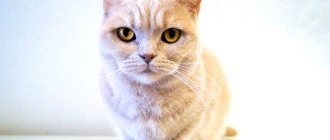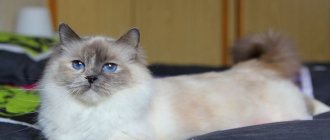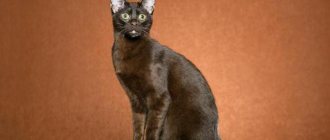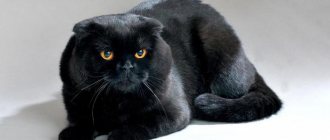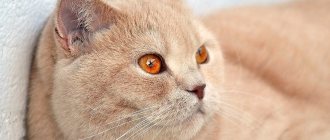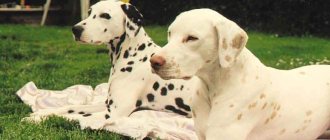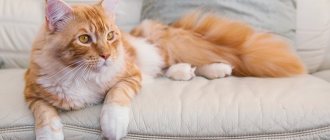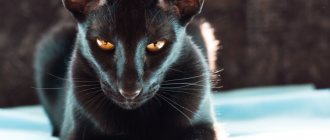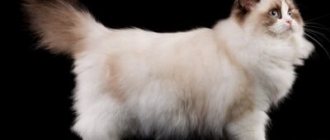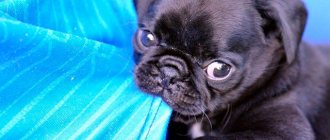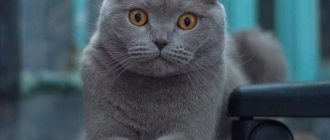There was a time when cream coloring in cats was considered a defect. Being too light, this color could not claim to be the standard of beauty among man's furry, mustachioed friends. But times change, and so does fashion. And now cream is not only no longer considered a flaw, this color has become popular, breeders have taken care to create such a shade in cats. Thus, the Persian breed of cats with a cream color was bred in the 20s of the last century.
The ideal cream color is associated with baked milk. It is this shade that one should strive for when breeding it from cats, although minor deviations are still allowed. In addition, the ideal color should be uniform in each hair from root to tip. Breeders also need to take this important parameter into account.
It is noteworthy that in the USA they prefer a less thick and saturated cream color tone than in the UK (here they will choose the golden mean). At the same time, experts and cat lovers around the world agree that a too dark tone is undesirable.
Photo of a cream British Shorthair
BLH e – longhaired cream
Varieties of colors of British cats
The parameters of one or another color of the British include not only the color of the coat. The tone of the undercoat, the pattern on the coat, the color of the nose and paw pads, and even the color of the eyes are important. Only British kittens that strictly meet the color standards should receive pedigrees. But in practice, sometimes these rules are not observed so strictly, so when purchasing, you should only contact trusted nurseries.
Hurry up, choose a box and find out what gift awaits you
Discount on pet insurance
Promo code copied to clipboard
British cats have only two colors: black and red. The remaining colors are only derivatives of the main ones, as breeders say, by diluting (colored) and suppressing (white) the color.
In order for an animal to meet the breed standard, it is necessary that it be evenly colored, every hair from tip to root must be dyed, there should be no white hairs (excluding, of course, white color), heels and noses must be even in color, without spots, residual Tabby spots should not be visible. Eyes - orange, dark golden, copper (exceptions are allowed in white and color-point animals).
Other peach-colored breeds
At first glance, it may seem that the colors of cats are evenly distributed across groups and are not subject to any regulation. In practice, everything looks completely different. Each population has “signature” colors that are familiar to a given breed. For the British it will be gray-blue, for Angoras it will be traditional white, Persians are almost always red, and Turkish Vans generally became the founders of a unique combination of white and red shades.
Peach wool did not become a distinctive feature of any of the breeds, although as a derivative of the red color it spread very widely.
Cats of the following breeds can have peach color in various shades:
In total, about fifty breeds, besides the British, can wear a wonderful peach coat, and the list only increases from year to year.
This is interesting! Even hairless cats (Canadian and Don Sphynxes) can be peach-colored.
Solid colors of the British
Some of the solid (with an emphasis on the "o"), or solid colors - such as blue - are the ancestors of the British colors, and some - new colors - were obtained through the labor-intensive work of breeders. The rarest solid colors are cinnamon and fawn.
White
Snow-white without yellowness. Kittens may have black or gray spots on their heads from birth, which disappear with age. The eyes can be blue, and heterochromia (difference of eyes) also occurs. Breeding experiments with this color have ended because too many kittens are being born with health problems. For example, deafness in white cats with blue eyes is common.
Black
The coal-black, raven-wing colors of British cats give the animal a witchy, magical appearance. But, unfortunately, it is difficult to guess that a black kitten will become a blue-black cat. Very often, kittens change color around six months, changing the color of their fur to chocolate.
Chocolate
The richer and darker the better. Kittens that have faded from black are usually not the most successful (brown) color. Noble dark chocolate is desirable.
Blue
It can be a little lighter and a little darker. The bluer the shade, the more valuable it is. The undercoat is sometimes lighter than the main hairs, but the difference should be minimal.
Lilac
A complex color that is a cross between blue and pink. The result of selection work. Kittens are born dull pink; With age, the animal acquires a light coffee-with-milk shade, with a pinkish tint.
Cream
Beige or peach shades. Kittens can be born with a variegated coat, but then the variegation goes away.
Faun
"Deer" color, even lighter than cinnamon cinnamon. In infancy, such a kitten can be confused with a cream kitten, but the older the pet, the more clearly the gray tone appears (in cream cats, red predominates).
Cinnamon (cinnamon)
A rare color, cinnamon color, similar to light chocolate with the addition of an orange tint.
A little history of the breed
There are several versions explaining the origin of the British cat breed. According to one of them, the history of the origin of the British cat is connected with the conquest of Britain by Rome. Allegedly, the Romans brought with them Egyptian cats, which over time adapted to their new habitat, acquired thick hair with excellent protective properties and, thanks to their unsurpassed hunting talent, became valuable pets.
This is confirmed by ancient mass graves of cats discovered by archaeologists in the cities of Badbury, Gassage, Danbury and All Saints.
According to another version, the history of the British cat is closely connected with the history of the French cat, the Chartreuse. These animals probably came to the territory of modern Europe from South Africa during the Crusades. At first they were bred by Carthusian monks in the Chartreuse monastery, and only then sailed to the British Isles along with French sailors, for whom they “served” as rat catchers.
This hypothesis is confirmed by the extraordinary similarity of the two breeds, the difference of which can only be seen by professional felinologists.
Chartreux are indeed very similar to the British
British cats were first introduced in London in 1880, and the first pedigree was written for them in 1898.
The First World War greatly affected the British population; cats of this breed were preserved only by breeders, thanks to whom they did not disappear. This state of affairs remained for quite a long time, and only after the Second World War a revival of the popularity of British cats and selection began. For this purpose, Persian cats and short-haired gray Chartreuse cats were used, therefore for a long time almost the only color of the British was blue (gray). However, hard work to restore and improve the breed has led to the formation of many possible colors - today there are more than 200 of them.
Color point colors
Color introduced into the breed by breeders. Sometimes it is also called “Siamese” or “Himalayan”. It has a rich palette of shades. According to the standard, a light body without spots and darkened legs, head, and tail. Wool with white undercoat. The eyes are blue, from watery-transparent to sapphire, bright blue, which is especially appreciated.
British pointing kittens are born almost white, with dark fur growing into adolescence, or even later. Over the years, both light and darker coats darken.
Black point (classic, seal point)
The most common color. On the body, the fur coat can range from white to almost chocolate color; the point markings are dark brown, turning into black. The nose and paw pads are black or black-brown.
Chocolate point
Rare beautiful color, one of the brightest. The cat's body is creamy in color, and the point markings are a rich chocolate color, which should be even and bright. The nose and paw pads are brown, maybe with a pinkish tint.
Blue point
Delicate, soft color. Cold tone. Gray-blue body and blue point markings. Looks very harmonious with ice blue eyes. The nose and paw pads are gray.
Lilac point
In this color there should be no sharp boundaries between the main color (white or almost white with a pinkish tint) and the gray-pink point markings. However, the difference in tones should be clearly visible. The nose and paw pads are gray-pink.
Red point
Quite a rare color. White or with a reddish tint coat, bright red point spots. The brighter the red, the better. Ideally, brick red color. The nose and paw pads are red to coral.
Cream point
Delicate creamy body color and smooth, easy transition to creamy point markings. The brightest spots are pink or coral nose and paw pads, as well as blue eyes.
Color point tortoises
A combination of two colors: color point and tortoiseshell. Delicate interesting color. Light body and spotted, mosaic markings. Point marks may contain a combination of any colors from the palette; soft, pastel colors are valued. The nose and paw pads match the base color.
Smoky color point
An interesting miracle of nature, or rather, the result of the work of breeders. Cats are carriers of two colors. The body can be any of the "smoke" colors: black smoke, blue smoke, lilac smoke, chocolate smoke, red smoke, cinnamon and fawn. Point markings are the same color, but darker. The undercoat is white, the nose and paw pads match the color.
Veiled color point
There are two types: on silver and on gold. On a silver-white or peach undercoat. Tipping on the back colors 1/8 of the hair in the tone of one color or another, point spots of the same color: black, blue, lilac, chocolate, red, cream, cinnamon and fawn. The nose and paw pads match the color.
Shaded color point
There are two types: on silver and on gold. On a silver-white or peach undercoat. Tipping on the back colors 1/3 of the hair to match the color of a particular color; point marks without sharp boundaries can be small. Black, blue, lilac, chocolate, red, cream, cinnamon and fawn. The nose and paw pads match the color.
Color point bicolor
Consists of two colors: white and any of the palette with point marks. As a rule, the chest, part of the body, the front legs are white, and there are also white spots on the cheeks. The symmetry of white spots and their harmonious arrangement are appreciated. Markings include black, blue, lilac, chocolate, red, cream, cinnamon and fawn. The nose and paw pads match the base color.
Fawn point
Light sandy body and light brown and beige markings. Exactly the deer shade, without the redness. Beige nose, beige paw pads.
Cinnamon Point
A very rare color, a breeders dream. Ivory coat and red-brown pointing markings. Red and pink-brown nose and paw pads.
Cream British kittens
The British peach cat never became the object of widespread breeding; most often, such animals are born as a result of selection of representatives of this breed with red fur. Peach-colored offspring are born only when both parents carry the appropriate genetic formula. And any deviations from the standard (for example, white hairs or pronounced tabby) can cause culling.
It is extremely difficult to get a peach British cat in order to continue the line with its help - females are most often born with a tortoiseshell color.
Those who want to buy a peach British cat come across mostly boys, for whom it is difficult to choose the appropriate pair for mating in the future. Therefore, all offers for cream cats come only from professional nurseries, and finding a high-quality kitten from the mating of two pets at home is almost impossible.
Tortoiseshell colors
The amazing thing about calico cats is that each one is unique. There are no identically colored turtles. Color types: finely spotted or patchwork, calico (spots on white). A very interesting joke of nature: only cats are tortoiseshells. Well, practically. Calico cats are much more rare than white crows. Cats can have such colors only due to a genetic error with chromosomes. Most breeders and felinologists, having worked with animals all their lives, have never encountered tricolor cats. But yes, one day such a kitten may be born. Unfortunately, there will be no offspring from him, although history knows exceptions. Turtles also include chimera cats, which amaze everyone with their appearance, whose faces are neatly painted in different colors. Chimerism is also a genetic anomaly.
There are six main subgroups of this color: classic tortoises, smoky tortoises, torbie (tortoiseshell tabby), tortie (tortoiseshell point), calico (patchwork tortoise) and mixed color (tortoiseshell tabby and white).
Bicolor tortoiseshell
This color is also called calico, or patchwork tortoiseshell. The brightest, most elegant color. On a white background there are colored spots, the boundaries of which are not blurred or mixed. The spots can be any color from the palette. Pigmented spots should cover more than a third of the body surface. If there are few colored spots on a white background, such animals are called harlequin or van.
Black and red tortoiseshell
Ideally, a cat should have approximately 50% red and 50% black spots. The brighter the spots, the better. Brownish and beige spots are the same red color, only lightened. According to the standard, a red spot on the forehead is very desirable.
Chocolate red tortoiseshell
Interesting, rarely seen color. Ideally, a cat should have approximately 50% red and 50% black spots. The brighter the spots, the better. There should be a light spot on the forehead.
Blue-cream tortoiseshell
Soft, delicate, very noble color. Pastel colors (blue and cream) blend smoothly into each other. White spots and even hairs are not allowed.
Lilac-cream tortoiseshell
Purple and cream spots are neatly distributed throughout the animal's body. White inclusions are not allowed. There should be a cream spot on the cat's face.
Cinnamon-red tortoiseshell
Rare tortoiseshell color variant. The color of the fur coat is warm and rich. The spots are evenly distributed; there should be a red spot on the animal's face.
Fawn-cream tortoiseshell
This color is rare. The spots are not bright, but nevertheless they should have a different color. White wool and residual tabby color are not allowed. But there should be a cream mark on the forehead.
Genetics of colors
The genetics of the formation of cream color in British cats is closely related to another primary color – red.
The second gene, which forms the cream color, is designated D (dilutor, dilutor). In the cat's genetic map, it affects lightening and comes in two forms: dominant D (no lightening) and recessive dd.
At the final point, black turns into brown, chocolate into lilac, cinnamon into fawn, and red into cream. Inheritance of color occurs only from parents to offspring.
It is important! Cream British kittens are only born when both parents have the D gene.
Tabby colors
The main signs of a tabby (or wild color) are the letter M located on the animal’s forehead (according to legend, this is the sign of a scarab), dark stripes near the eyes and on the cheeks, as well as rings (necklace) on the neck and chest.
Marbled Tabby
Dark circles, swirls and patterns on a light background. The pattern should be clear, not tangled or intersecting.
Spotted Tabby
Stripes on the cheeks, a dotted stripe along the ridge, and spots on the sides, preferably clearly defined and bright, are required. The cat is a micro-leopard.
Striped tabby
Brindle (sprat, mackerel, striped) is the most common tabby color. Mackerel (mackerel) fish, as well as sprat fish, have tiger stripes on their scales, just like cats have on their fur, hence the name.
Distinctive features are a dark stripe along the ridge, extending onto the tail, and striped sides. It is important that the stripes are not interrupted and do not turn into spots. The cat is a micro-tiger.
Patterned with white (torbico)
Quite a rare color, consists of three: tabby, tortoiseshell, white. On a white background there are colored spots with one of the tabby patterns.
Pictured tortoiseshell (torby)
The animal has a tabby pattern under any of the coat colors (black-red, chocolate-red, blue-cream, lilac-cream, as well as cinnamon-red and fawn-cream).
Silver tabbies
The cat's fur has a black pattern (stripes, spots, marble), and a white and silver undercoat.
Golden tabbies
The cat's fur has a red pattern (stripes, spots, marble), and an apricot undercoat.
Silver chinchilla
It is still a rare, difficult to breed, but very beautiful, “royal” variety of the British cat. The color is so named because of its resemblance to the fur of real chinchillas.
The beauty is the owner of a snow-white fur coat with a “spraying” of the main color tone, black or blue. No yellow shades of wool are allowed. The nose and paw pads should match the base color. The eyes are necessarily green, except for the pointed subspecies. The colors differ in the degree of coloring of the hairs.
Silver shaded
Shaded is when only the upper third of the hairs are colored in the main color. In all other respects, the animal looks like it has a solid color, only slightly “dusted.” This effect is achieved due to the fact that each hair has a colored tip. The undercoat is white.
Silver veiled
Veiling is when the top 1/8 of the hairs are colored. In all other respects, the animal looks the same as with a solid color, only in a barely visible transparent “veil”. This effect is achieved due to the fact that each hair has a colored tip. The undercoat is white.
Golden chinchilla
An even rarer, difficult to breed, but very beautiful, “sunny” variety of the British cat. Its color is so named because of its similarity to the fur of real chinchillas.
This cat wears a bright apricot-colored coat with black or blue “spraying.” The brighter the gold, the more valuable it is. Gray shades are not allowed. The nose and paw pads should match the base color. The eyes are necessarily green, except for the pointed subspecies. The colors differ in the degree of coloring of the hairs.
Golden shaded
Shaded is when only the upper third of the hairs are colored in the main color. In all other respects, the animal looks like it has a solid color, only slightly “dusted.” This effect is achieved due to the fact that each hair has a colored tip. The undercoat is peach or apricot.
Golden veiled
Veiling is when the top 1/8 of the hairs are colored. In all other respects, the animal looks the same as with a solid color, only in a barely visible transparent “veil”. This effect is achieved due to the fact that each hair has a colored tip. The undercoat is peach or apricot.
Features of breeding fold cats
If you want to try your hand at breeding purebred cats, then it’s better to start by studying in felinological courses, which teach the basics of genetics, veterinary medicine, and tell you about the rules for holding exhibitions and about international felinological organizations. Before organizing the mating of your pet, it is necessary that he take part in the exhibition. Even if the cat did not take a prize, it received a rating for its class, this could be:
- Pet class is an animal with a slight defect that cannot be used in breeding work.
- Breed class - full compliance with the breed standard and in good health for procreation.
- Show-class - not only compliance with the standard, but also a bright appearance, which allows you to receive prizes at exhibitions.
Only after receiving the class can your pet officially take part in the breeding work of the felinological club.
The difficulty in breeding fold cats lies in the correct selection of partners. Under no circumstances should fold-eared cats be mated with fold-eared cats. In such a mating, all offspring will have genetic diseases. In addition, the color of the animals is taken into account to obtain the best result.
It is advisable to breed young animals with more experienced partners at the age of about one and a half years (a cat during the third heat). To find a suitable partner, a felinological club is used and the act of mating is documented so that the kittens born have a correctly issued passport.
Smoky colors
“Smoky” can be any of the colors, the main thing is that the undercoat should be lighter than the main color, preferably white. This is one of the varieties of hair color distribution. About half of the hair is colored, and closer to the root half is white. There are also “cameo” colors, in which the color of the undercoat almost merges with the color of the main hairs.
Classic smoky
“Smoke” is superimposed on the same solid coat colors: black-red, chocolate-red, blue-cream, lilac-cream, as well as cinnamon-red and fawn-cream. The undercoat is silvery-white.
Smoky bicolor
The cat has a symmetrically and harmoniously distributed white color and “smoky” spots of any color. The undercoat is white, the nose and paw pads match the base color.
Colors with white
A cat can have any of the following colors: black, blue, lilac, chocolate, red, cream, cinnamon and fawn, as well as a combination of these plus white spots. One fourth (no less!) part of the body should be white - this is the chest, front legs, cheeks, and belly. The nose and paw pads should match the base color.
Classic color with white
Strictly speaking, this is a two-colored cat. Elegant white spots (yellowishness is not allowed) and a fur coat of any of the classic colors. The nose and paw pads match the base color.
Smoky color with white
The cat has a symmetrically and harmoniously distributed white color (chest, paws, cheeks) and “smoky” spots of any color.
Color point with white
The elegant coat of such a cat is painted in two colors: white and any of the palettes with point marks. The chest and front legs are white, and there are also white spots on the cheeks. The symmetry of white spots and their harmonious arrangement are appreciated. Markings of black, blue, lilac, chocolate, red, cream, cinnamon and fawn. The nose and paw pads match the base color.
Colors with white tabby
The same patchwork turtles, only some spots may have a tabby pattern. Rarely seen, it is considered a combination of three colors. There may also be spots of the same (any) color, on which a tabby pattern appears (stripes, spots, marble).
How to determine the color of a British cat?
If you really need a kitten of a certain color, you should contact a cattery with a good reputation. It’s not a fact that you will immediately find what you want, especially if the color is rare. Ask for photos, videos; Perhaps they will show you the baby on Skype. Then it’s time to go and choose.
To begin with, visually, but the kitten must already be mature (3-4 months). In babies, the color may change color.
Look at the kitten's parents, talk with the owners, study the breed codes and the summary color table. The exact details of cat fathers and mothers must be indicated in their documents. Using the table, you can determine which kittens a given pair of producers may have.
Well, or you can contact a specialist, an expert felinologist. In the case of rare and complex colors, it is better not to take risks. Interestingly, all cats are initially wild-colored (tabby). That is, spotted. But due to a combination of genes, this color is hidden. Nature's jokes can be observed in small kittens, which, being born with spotted fur, change to one color within a couple of months.
Is there a breed of British Fold?
If you try to find this breed in the list of FIFe or other international felinological organizations, you will fail. Officially, the “British Fold” breed does not exist (British breeds are divided into short-haired and long-haired, both of which have beautiful erect ears). What kind of cats are called “British Fold”?
The history of the origin of the fold cat breed
Cats with folded ears were first officially registered in 1961. The cat Susie became the ancestor of a new breed, which was later called the Scottish Fold. Cute plush cats with large bright eyes and a very balanced character quickly gained popularity and in 1976 were officially recognized as an independent breed. During the period of breeding work, an unpleasant fact was revealed: when crossing two lop-eared parents, the offspring have a number of genetic diseases and are not viable. Therefore, crossbreeding was carried out with other short-haired breeds: exotics, British and Americans. In this case, the litter could contain both fold-eared kittens (Scottish Fold) and babies with erect ears; they were called Scottish Straight (this variety later also received the status of an independent breed).
Currently, mixing Scottish cats with British Shorthairs is prohibited, as this contributes to the development of genetic diseases. The British Fold cat breed does not officially exist. Scottish Folds are offered under this name, but since the ancestors of this breed were also British, there is some basis for using such a name. Such pets touch with their appearance and captivate with their sweet character, so they enjoy well-deserved popularity.
Photo gallery: British and Scottish cats
Blue British Shorthair
Longhaired British (Highland) golden chinchilla color
Long-haired Scottish cat with straight ears (Highland Straight) tabby color
Long-haired Scottish fold cat (Highland fold) bicolor color
Shorthair Scottish cat with erect ears (straight) red tabby color
Shorthair Scottish Fold cat (fold) gray point color
